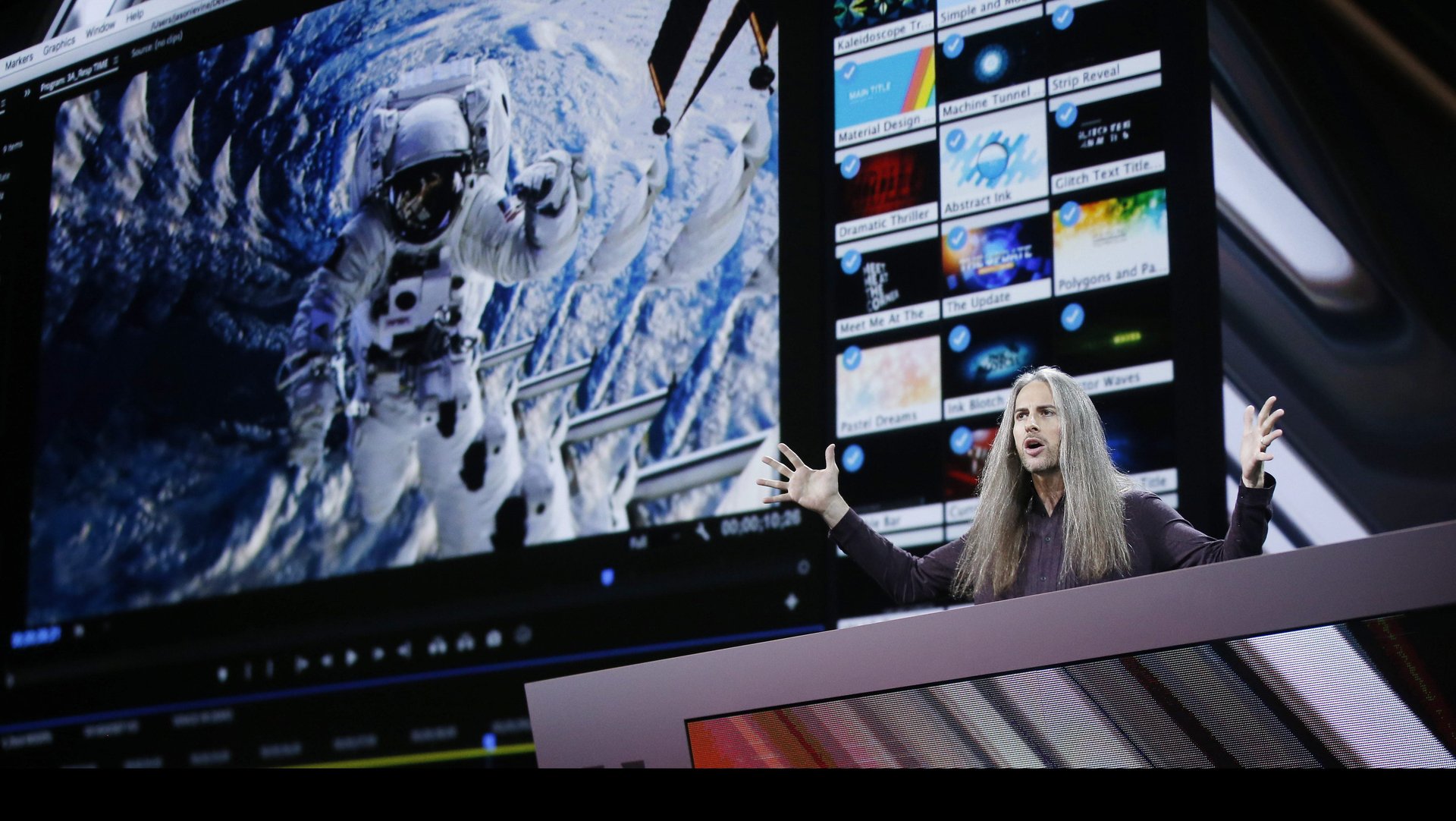Tech-challenged designers are flocking to a guy they call “Adobe Jesus”
The design industry is drowning in tech. Not too long ago, creative professionals were limited to a few software programs to do their work. Graphic designers, for instance, had Adobe InDesign, Quark XPress and, for truly old-school layout whizzes, Aldus Pagemaker. Every update was an occasion to consider how and if the new version might suit their practice. But with faster development cycles and the advent of cloud-based software delivery, new features enter the work stream instantaneously. Every time you fire up a program these days, it seems there’s a new trick and shortcut to discover. Designers, more than ever, need a savior from the unceasing upgrades.


The design industry is drowning in tech. Not too long ago, creative professionals were limited to a few software programs to do their work. Graphic designers, for instance, had Adobe InDesign, Quark XPress and, for truly old-school layout whizzes, Aldus Pagemaker. Every update was an occasion to consider how and if the new version might suit their practice. But with faster development cycles and the advent of cloud-based software delivery, new features enter the work stream instantaneously. Every time you fire up a program these days, it seems there’s a new trick and shortcut to discover. Designers, more than ever, need a savior from the unceasing upgrades.
Enter Adobe Jesus.
Sound engineer Jason Levine—or “Adobe Jesus” to his acolytes—is among Adobe’s elite software trainers, with an actual job title of “principal worldwide evangelist.” Blessed with a preacher’s charisma and a luxurious mane reminiscent of that new testament Nazarene, Levine has been commanding the attention of thousands for the last 17 years. His typical online tutorial garners anywhere from 10,000 to 20,000 unique views from all over the world. Last year, about 11,000 creative professionals attending the Adobe MAX conference watched in rapture as Levine showcased upgrades to film editing software. There was chanting, there was group clapping, there was singing. In previous years, there was even high-kicking—all in an effort to make Adobe’s latest software features stick.
The rise of tech evangelists
Starting with Apple in the early 1980s, tech companies began hiring evangelists to spread the word about their products. The most influential Silicon Valley preacher was, of course, Steve Jobs. Decades before Instagram influencers and YouTube how-to tutors, these experts spoke at conference after conference to personally meet customers. The job is a cross between engineering and marketing, requiring expert-level proficiency, personal charm and a love for public speaking.
In many instances the CEO serves as the de facto evangelist, but other companies with a complicated range of products and services like Adobe need dedicated specialists. Microsoft, Google, and HP have evangelists on their staffs. Several start-ups such as Australian design software company Canva also rely on brand ambassadors to take them from “zero to critical mass.” There are also subject matter evangelists such as Eric Ries for lean startups and Vint Cerf, Google’s chief internet evangelist. Innovation evangelist Theo Priestley argues in Forbes that an evangelist is the human counterpoint to automated marketing. “Evangelism is something you just can’t hand over to a robot,” he writes.
Guy Kawasaki, chief evangelist at Canva and formerly chief evangelist at Apple, wrote the gospel on the rarified craft. Through bestselling books, lectures and now an online course, the soft spoken, easygoing Kawasaki promotes a method that involves “delivering the good news” with high-minded reason. In the early 1980s, he led the famed campaign that “stopped the worldwide domination of IBM” built around George Orwell’s dystopian novel 1984. ”It was more of a cause for us,” he explained in a 2016 interview with Draper TV. “This was an epic struggle against totalitarianism. … This was to preserve freedom, to preserve creativity and productivity. This was a very emotional sell.”
A complex messiah
In contrast to Kawasaki’s brand of tempered salesmanship, Levine’s approach is more rock and roll.
As a child, he was hooked on classical music, favoring dramatic Baroque piano pieces like his favorite, Franz Liszt’s rousing Hungarian Rhapsody No. 2. “That was the piece in those Merrie Melodies cartoons! I wanted to play that,” he tells Quartz, recalling the Looney Toons classic starring a tuxedoed Bugs Bunny.
Levine says that while he enjoyed performing in the classical music circuit, he was more excited by the rush of appearing on stage than slavishly perfecting the 17th century scores.
After graduating from the Berklee College of Music, Levine took to the road. He worked as a sound mixer for legendary film score composer Hans Zimmer and jazz pianist Herbie Hancock. In his 20s he moved across the US to pursue the next gig—Nashville, Los Angeles, San Francisco, New York, Boston and Miami. He’s also operated his own music publishing company, earning royalties from tracks licensed by various cable TV shows.
Levine became entrenched in the world of software evangelism as one of the first employees of Syntrillium Software in Phoenix, Arizona. Making tutorials for a digital audio product called Cool Edit Pro, Levine began crafting a style and language that would resonate with designers and engineers. Cool Edit was acquired by Adobe in 2003 and repackaged as Adobe Audition. Audiences found Levine’s style so compelling that he quickly rose within Adobe’s evangelism program. One fan published a YouTube clip she titled “The Best Keynote Presenter Ever.” He’s now the go-to expert on Audition and Premiere Pro CC, Adobe’s video editing software. Levine describes tech evangelism as “proselytizing through passion and belief.”
“If I don’t believe in it, I don’t talk about it,” he says.
The hair factor
Cultivating a unique personal style is key to evangelism and, with Levine, it’s all about the hair. “My look is more 1970s touring hard rock, maybe even glam,” he jokes.
After a few years as Adobe’s resident “hair guy,” Levine started to get self-conscious about his locks. He worried that his look might be overshadowing the expert technical message he was delivering. He started to wear his hair up in a Euro bun (not a man bun, he’s quick to distinguish) to present a more business-like persona—albeit with sideburns Elvis Presley would covet. In the end, Levine says he had to let his locks flow free. “You know, I can be the hair guy and people can take me seriously too—and I like being this person,” shares Levine, who is in his 40s.
So does he like the “Adobe Jesus” nickname?
“I was very touched and quite speechless—and even choked up right now,” says Levine. “I’m very grateful to these things, and I appreciate the association. It’s one of those things, if the community thinks it’s cool, then I’m cool with it too.”
Preaching to the internet
Over the years, Levine has tailored his style to fit today’s dwindling attention economy. In an age where TED has weaned us on 18-minute talks, and social media has conditioned us to expect tweetable wisdom, Levine says he has to constantly come up with new tactics to keep everyone engaged. Eschewing a script, Levine likes to improvise when he goes on stage. At this year’s Adobe MAX conference, he broke into a ditty about “Motion Graphics Templates in Adobe Stock.”
Levine prides himself with the ability to read a crowd—like a stand-up comic or a rhapsodic televangelist. He prepares for these nerve-wracking appearances by practicing transcendental meditation. “Energy harnessing, that’s the main thing I get from meditation.” he explains.
When doing an online tutorial, Levine says he’s careful about using American clichés that may not be understandable to everyone watching. “We have all these baseball colloquialisms, and they mean nothing in other parts of the world,” he says. He’s also learned to nix hyperbole, in favor of a more intimate, conversational style for online tutorials.
“In the short attention span world that we’re in, you’ve gotta wake people up,” emphasizes Levine. He likens the outline of his tutorial to a song’s structure: “If you’re going to build to a crescendo, you have to bring it back down,” says Levine. “I’m also very big on long, dramatic pausing—sometimes for effect, sometimes to make things almost uncomfortable or add a little bit of humor. It’s about timing, pacing, delivery.”
Levine mixes live demo with singing, self-deprecating comedy with earnest testimonies about his technical shortcomings (he has terrible font anxiety, he says). After a particularly “miraculous” time-saving operation, Adobe Jesus likes to belt out a long note—aaaaaaaaaaaaaaaaaa. Call it Levine’s hallelujah.
He caps each module with a kind of relatable take-away: “This is really something anyone can use. … It doesn’t matter if you’re a video professional or if you’re just shooting something on your phone and you want to add a nice soundtrack. … Adobe Audition Remix gives you that power.”

Inevitably, there are trolls and haters. But he says, it’s all par for the course. A father of two boys, he’s careful about keeping his private life out of social media. Last year, he opened up about having kids to contextualize songs like Put Your Pants On or Pirate Teeth on his Spotify channel. “Otherwise I’m just a creepy, long haired guy who writes children’s songs,” he laughs.
After nearly two decades in Adobe’s pulpit, Levine remains intent on empowering creative dabblers of all skill levels. “I hope to create the desire for art—art whether it’s visual, sonic, or virtual. Whenever I speak to individuals to groups of people, I really want to make them feel empowered, even if it’s just the idea,” says Levine. “I hope to give someone who’s listening something achievable or just the inspiration to look further.”